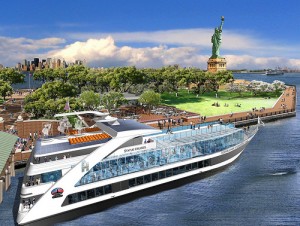 Hornblower Hybrid, the nation’s first vessel powered by diesel, hydrogen, batteries, wind and solar energy, arrived today in the New York Harbor. After nearly two years of construction and the work of more than 300 individuals, the Hybrid will service New York City upon completion of United States Coast Guard sea trials and certifications. The innovative vessel reduces emissions, uses minimal diesel, and features several recycled and reclaimed materials, LEED-certified carpet and energy-efficient LED lighting.
Hornblower Hybrid, the nation’s first vessel powered by diesel, hydrogen, batteries, wind and solar energy, arrived today in the New York Harbor. After nearly two years of construction and the work of more than 300 individuals, the Hybrid will service New York City upon completion of United States Coast Guard sea trials and certifications. The innovative vessel reduces emissions, uses minimal diesel, and features several recycled and reclaimed materials, LEED-certified carpet and energy-efficient LED lighting.
 Terry MacRae, CEO of Hornblower Cruises & Events said, “The Hybrid marks a milestone in sustainable maritime transportation. What better time to unveil it to the world than on the anniversary of one of America’s most iconic national parks and landmarks. As a concessionaire to the National Park Service, we constantly strive to help conserve and protect the parks we serve,” “The Hybrid marks a milestone in sustainable maritime transportation. What better time to unveil it to the world than on the anniversary of one of America’s most iconic national parks and landmarks.”
Terry MacRae, CEO of Hornblower Cruises & Events said, “The Hybrid marks a milestone in sustainable maritime transportation. What better time to unveil it to the world than on the anniversary of one of America’s most iconic national parks and landmarks. As a concessionaire to the National Park Service, we constantly strive to help conserve and protect the parks we serve,” “The Hybrid marks a milestone in sustainable maritime transportation. What better time to unveil it to the world than on the anniversary of one of America’s most iconic national parks and landmarks.”
Marking its public debut, the Hybrid will participate in the Statue of Liberty’s 125th Anniversary Flotilla on Oct. 28 at 10 a.m. to 2 p.m., from Pier 40 to the Statue. It will exhibit in the parade of ships in honor of the Statue’s original dedication from France on Oct. 28, 1886. Next year, the Hybrid will run harbor cruises with close-up views of Ellis Island and the Statue of Liberty. Corporate, social, school and wedding events are bookable on the Hybrid now, while public harbor cruises begin in early 2012. The Hybrid is part of Hornblower New York’s four-vessel fleet, which will include three other luxury entertaining yachts arriving next year. Hornblower New York is a subsidiary of Hornblower Cruises & Events, one of the largest charter yacht, dining cruise and eco-tour companies in the country. The company operates America’s first hydrogen hybrid commercial vessel, the Hornblower Hybrid, and will launch a four-boat fleet in 2012.
Greece to Use Solar Project Revenue to Pay Debt

